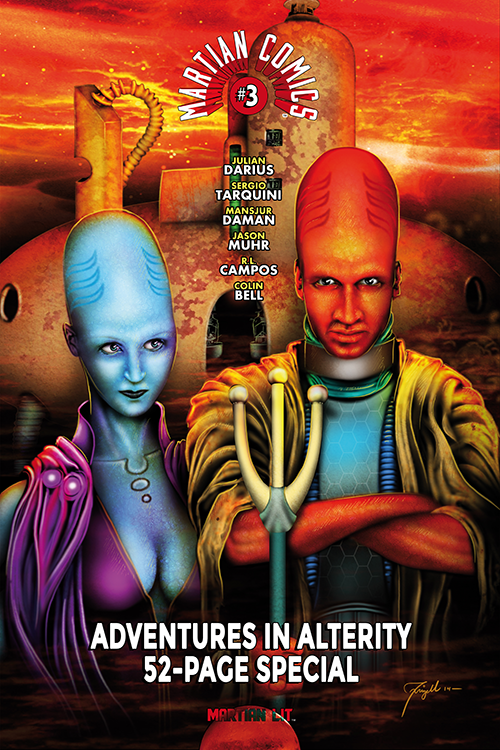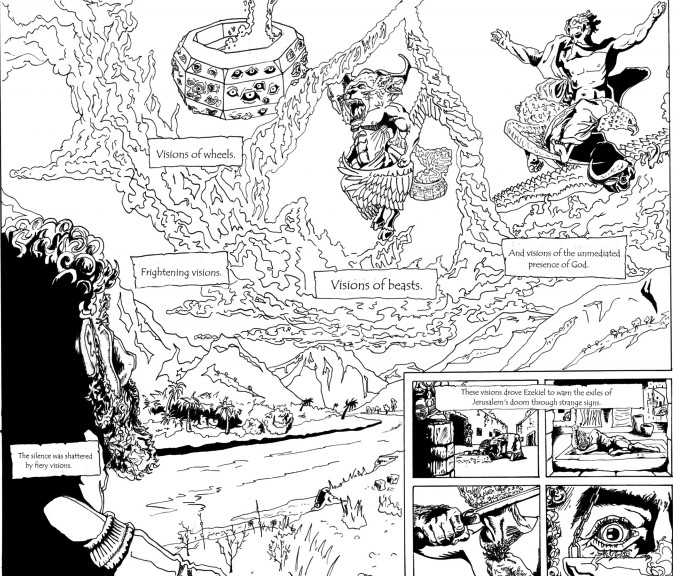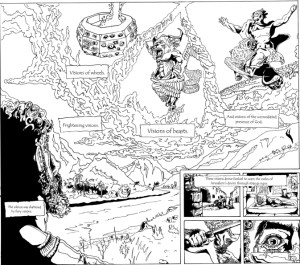 This past month, Sacred and Sequential had the opportunity to chat with Julian Darius, President & Founder of the Sequart Organization and creator of Martian Comics from his own Martian Lit imprint. With the release of the Kickstarter-funded Martian Comics #3 and its intriguing religious content, he talks with us about the wide range of thinking behind his (not-so-)alien tales.
This past month, Sacred and Sequential had the opportunity to chat with Julian Darius, President & Founder of the Sequart Organization and creator of Martian Comics from his own Martian Lit imprint. With the release of the Kickstarter-funded Martian Comics #3 and its intriguing religious content, he talks with us about the wide range of thinking behind his (not-so-)alien tales.
S&S: Before we focus on the most recent Martian Comics #3, perhaps you could outline what “Martian Mythology” is and what was involved in producing these works?
JD: The “Martian mythology” is essentially the backstory of the whole series. Back when I founded Martian Lit, I thought it would be funny to have it actually run by Martians, and I worked up this backstory of planetary orders, an enlightenment program (that included Jesus and others), the cloaking of Mars’s cities, and the sort of vague threat that the Martians are still debating and split over whether to invade. There was a lot of detail for what was essentially a complex joke.
When Kevin Thurman pitched me on what became “The Girl from Mars,” it was wedded to this backstory I’d worked up for Martian Lit. As we collaborated on the early “Girl from Mars” chapters, I began expanding this backstory and writing these other Martian stories. It’s kept growing. It’s really because of this that the series is called Martian Comics — a throwback to titles like Adventure Comics and whatnot — and wasn’t titled The Girl from Mars. Initially, “Martian mythology” was a way of separating this backstory I’d created and was exploring in these side stories from “The Girl from Mars.” “Martian mythology” is kind of the backbone of the series — “The Girl from Mars” is the first story, the first window into that mythology.
But this “Martian mythology” has kept growing. There’s a map of stories waiting to be told, whole arcs of Martian history, ways in which themes echo throughout the stories and into the various more narrow stories, like “Girl from Mars.” It’s a pretty vast thing, which I’ve kind of put together over the past several years and keep adding to.
 Continue reading The Martian Chronicles of Julian Darius, Part I →
Continue reading The Martian Chronicles of Julian Darius, Part I →
 Jason Aaron’s The Goddamned is best described as a cross between the Bible and Mad Max, with all the brutality and wit that implies. But somehow it goes so far into the depths of inhumanity that it crosses over into being funny, and even joyful. There’s the spirit of a dare about the whole book, as if the creators are just pushing their imaginations as far as they can be pushed, well beyond the realm of bad taste. For example , an early scene in issue #3 features a flashback to just after Adam and Eve are expelled from the Garden of Eden, and Eve spits out the charming line, “Fuck you. The snake was more man than you are, you dickless coward.” Adam, serene and buff, simply cradles Cain in his hands and points out that the whole world is his for the taking. And what a world it is.
Jason Aaron’s The Goddamned is best described as a cross between the Bible and Mad Max, with all the brutality and wit that implies. But somehow it goes so far into the depths of inhumanity that it crosses over into being funny, and even joyful. There’s the spirit of a dare about the whole book, as if the creators are just pushing their imaginations as far as they can be pushed, well beyond the realm of bad taste. For example , an early scene in issue #3 features a flashback to just after Adam and Eve are expelled from the Garden of Eden, and Eve spits out the charming line, “Fuck you. The snake was more man than you are, you dickless coward.” Adam, serene and buff, simply cradles Cain in his hands and points out that the whole world is his for the taking. And what a world it is.
 WUSTL’s “Hold That Thought” podcast
WUSTL’s “Hold That Thought” podcast




